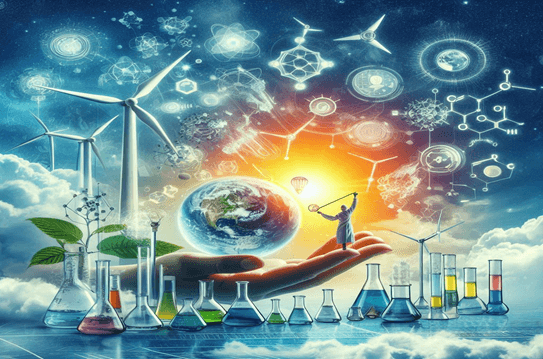Chemistry in Renewable Energy: Innovations and Applications
Published Date: 12 Oct 2024
Chemistry is the science that is involved the most in building the future of renewable energy. From photovoltaics to energy storage technologies and from carbon-neutral biofuels to other areas-providing the bedrock innovation that is changing how we produce and consume energy. Considering the shift to cleaner sources of energy to counter climate change and minimize reliance on fossil fuels, advances in chemical science are now giving the required tools to create a more efficient system of clean energy. In this segment, we shall discuss some of the innovations and applications of chemistry in the renewable energy sector.

Innovations:
Chemistry innovations for renewable energy set up the future for sustainable energy technologies. Among these innovations, key include:
1. Perovskite Solar Cells
Perovskite-based photovoltaic cells represent a major step in the development of photovoltaic technology. Such materials convert sunlight into electricity more efficiently than classical silicon-based cells and can be produced at a cheaper price. One more advantage of the flexibility of perovskite provides new applications, such as lightweight and even transparent solar panels.
This is a new energy storage technology: solid state batteries with higher energy density and improved safety and life than standard lithium-ion batteries. Using a solid electrolyte minimizes leakage and improves battery performance for applications in electric vehicles and grid energy storage.
2. Green Hydrogen Production
Chemistry plays an important role in the development of efficient catalysts for green hydrogen production by water electrolysis. Innovations include using renewable electricity, such as solar or wind power, to split water into hydrogen and oxygen. Zero-emission hydrogen fuel is thus produced through such electrolysis for energy storage, transportation, or industrial use.
3. Biofuels from Algae
Algae, rich in oil and high-rate reproducers, have been used to produce biofuels through the application of chemistry. Algae biofuels are renewable fuels that will substitute the use of fossil fuels. They tend to emit fewer greenhouse gases. Advanced chemical processes used in hydrothermal liquefaction are making it easier and more affordable to produce algae biofuels.
4. Advanced Catalysts for Fuel Cells
Fuel cells will consume hydrogen and oxygen to produce electricity, with new platinum-free catalysts, which could significantly lower costs and increase efficiency. Innovations that bring fuel cells closer to practical implementation for a range of applications from power for electric vehicles to providing backup power for renewable energy systems are being developed.
5. Electrocatalysis for Carbon Capture
Electrocatalysis has been explored to provide new technology in carbon capture and utilization. The successful outcome of such innovative catalysts may not only present mechanisms for the conversion of captured carbon dioxide into useful chemicals or fuels but, further improve, reduce the emission of greenhouse gases, and form a circular carbon economy, and therefore, will have chances that could mitigate climate change while it has the prospect of not only creating a new source of energy.
Applications:
Some of the important applications include the following
Solar Energy and Photovoltaic Cells
Photoelectrochemical Cells (PEC) Chemistry is also one of the main constituents in the design of photoelectrochemical cells, which can split water into hydrogen and oxygen in the presence of sunlight — sometimes referred to as solar water splitting. PECs exploit catalysts and semiconductor materials for the production of green hydrogen, a clean fuel source that has very bright prospects for implementation in all industries, from transportation to industrial manufacturing.
Energy Storage System
Lithium-Ion Batteries: Chemistry has improved the energy density and lifetime of electrochemical systems, from light electric vehicles to grid storage. Better properties of the electrolytes, cathode material such as lithium iron phosphate are increasing efficiency in energy storage.
Solid state replacement of liquid electrolytes would help have promising possibilities of higher energy density and safer storage, especially in the world of electric vehicles.
Biofuels and Biomass Conversion
Ethanol and Biodiesel Production: Chemical processes in fermentation and transesterification improve the yield of biofuels from plant materials and waste. In these two processes, the produced biofuel serves as an intermediate fuel in both transportation and power generation.
Second-Generation Biofuels: Chemistry breaks down the non-food biomass into fuels, such as cellulosic materials and algae, reducing dependency on feedstocks like corn and sugarcane.
Wind Energy: Composites and Lubricants
Composites blade materials: Chemistry helps in developing a new generation of stronger, lighter material wind turbine blades made from carbon-fiber composites with consequent improved turbine efficiency and minimized maintenance cost.
Superior lubricants: Chemical composition of more advanced quality lubricants for enhancement in the efficiency of turbines to reduce friction thus leading to smooth operation with reliability of turbines over long periods of operation.
Electrochemical Water Purification
Chemistry is designing electrochemical techniques that can focus on the desalination of water or removal of contaminants using renewable energy sources for the powering of the purification process. This application is of vital importance, as clean water supply places where the resource may be short, usually powered by solar or wind systems.
Geothermal Energy
Corrosion-Resistant Materials: Chemistry is applied in designing geothermal power systems, which renders the materials produced resistant to the corrosive environments typical in deep wells. This gives long-term durability and efficiency for geothermal power plants.
Heat Transfer Fluids: Advanced chemical formulations of heat transfer fluids render extraction and storage of geothermal energy possible with increased production from geothermal power systems.
Conclusion
Chemistry is a propeller that has pushed innovations in renewable energy technologies. From improvements in efficiency for solar cells, with better batteries to sustainable biofuel development up to optimized designs for wind turbines, chemistry has been quite ubiquitous and priceless. The removal of the barriers to renewable energy adoption would have to persist in relying on the sciences in chemistry as a requirement for the pursuit of a cleaner energy future to become more sustainable and resilient in the energy landscape of the future.
Maximize your value and knowledge with our 5 Reports-in-1 Bundle - over 40% off!
Our analysts are ready to help you immediately.
